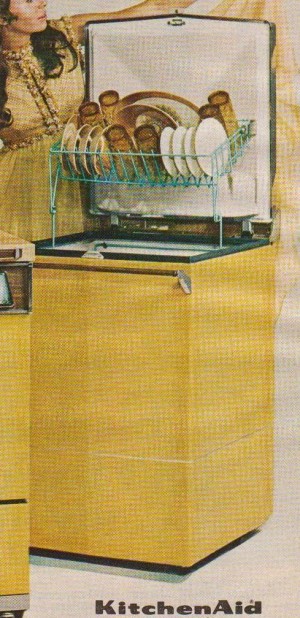Top Loading Dishwasher
 I found an ad for a top-loading portable dishwasher from Kitchen Aid on Flickr. You can see the full ad here:
I found an ad for a top-loading portable dishwasher from Kitchen Aid on Flickr. You can see the full ad here:
I understand the appeal of top-loading because there is no way that water can leak and spill all over your kitchen floor. Anyone who has had a dishwasher with that problem understands the desire to contain that potential mess.
The CAPACITY, however is so low! Imagine only being able to wash ten plates and six glasses! No pots or pans, just service for six (or so).
I’m sure that front loading dishwashers came into existence so they could be installed under counters, not because of their limited dish capacity. They must have been around for only a short amount of time, because I’ve never seen a top-loading dishwasher in my life. Honestly, I’ve only ever seen two portable dishwashers, period.
What was once a “fashion” or a luxury, has now become a housing staple. My first apartment didn’t have a dishwasher, but I’m sure it does now. It surprises me how quickly gadgets advance within one lifetime.
I’ll vouch for the existence of the 1970’s top-loading dishwasher. We had one when I was a kid (moved into the house in 1982)–it was brown with a butcher-block top.
It was a pain in the neck to load and unload.
Comment by Dixie — June 18, 2009 @ 9:05 am
just wanted to say that i’ve got an earlier model kitchenaid top loading dishwasher (kd-2p, circa 1958-1963), and there’s a rack in the bottom that isn’t shown in this ad, effectively doubling it’s capacity. this ad is showcasing the fact that the top rack is attached to the lid, and pulls up when you open it to automatically grant access to the bottom. the earlier ones you’ve got to remove the top rack and set it aside while loading the lower rack. just thought i’d point out that the capacity really isn’t too different from most modern dishwashers.
Comment by scurl — August 17, 2009 @ 11:25 pm
Scurl,
Thank you so much for clarifying that! Glad to know that those old dishwashers were more efficient than the ad made them seem!
Laura
Comment by Laura Moncur — August 18, 2009 @ 7:08 am
My daughter in herited the one you seem to be talking about Scuri. She can’t find both soap dispensers and it doesn’t seem to fill all the time. Can you give any help?
Comment by Bonnie — November 30, 2009 @ 6:32 pm
The soap dispenser is located at the top of the back wall. Turn it right side up, fill, flip down the lid and fill the lid with detergent. If it doesn’t release during the 2nd wash, tug the control panel a bit toward the front of the machine. Don’t use the control panel to pull the machine around. I bought my KitchenAid top-loader in 1968, for use in a small college apartment kitchen. I couldn’t ‘afford’ real estate for opening a front-loading door and I found the 4 sq. ft. cutting board top useful. It was noisy because there was no insulation. It did require learning how to load, but I could easily wash 12 dinner plates, salad plates, bread & butter plates, plus all the silverware, and 24-30 glasses/mugs in the two top racks — never any water collected on the top of a mug. One must be very careful to not let stemmed glasses in the top rack front row catch under the lip of the machine. I repaired the KitchenAid myself, using it for 40 years until I moved to a senior apartment with a built-in. I gave it to someone who is still using it. The built-in — named after a toilet bowl, whirling and pool — doesn’t hold anything well. I have to run it every day to keep up. Things fall over in the racks, becoming scratched and chipped and there’s always water on the top anything that can collect it. I miss the KitchenAid. And it never melted anything.
Comment by David — March 13, 2010 @ 1:39 pm
What I remember most about our old top-loader (I don’t recall the make or model–it was “old” by the early 60s) is the way the lid latch would retract at the end of the rinse cycle, allowing the lid to pop up to suck out the steam and provide for some rudimentary drying. If you weren’t prepared for it, the noise could be quite startling! Also, the technique wasn’t very effective, and we often finished up the drying with a towel so we could put the dishes away.
Comment by John — March 19, 2010 @ 3:56 am